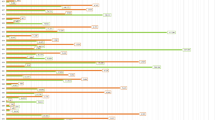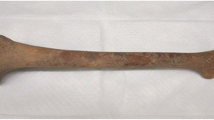Abstract
The aim of this study was to demonstrate the presence of the A189G age-related point mutation on DNA extracted from bone. For this, a peptide nucleic acid (PNA)/DNA sequencing method which can determine an age threshold for the appearance of the mutation was used. Initially, work was done in muscle tissue in order to evaluate the sensitivity of the technique and afterwards in bone samples from the same individuals. This method was also applied to ancient bones from six well-preserved skeletal remains. The mutation was invariably found in muscle, and at a rate of up to 20% in individuals over 60 years old. In modern bones, the mutation was detected in individuals aged 38 years old or more, at a rate of up to 1%, but its occurrence was not systematic (only four out of ten of the individuals over 50 years old carried the heteroplasmy). For ancient bones, the mutation was also found in the oldest individuals according to osteologic markers. The study of this type of age-related mutation and a more complete understanding of its manifestation has potentially useful applications. Combined with traditional age markers, it could improve identification accuracy in forensic cases or in anthropological studies of ancient populations.

Similar content being viewed by others
References
Harman D (1972) The biologic clock: the mitochondria? J Am Geriatr Soc 20:145–147
Beckman KB, Ames BN (1998) The free radical theory of aging matures. Physiol Rev. 78:547–581
Michikawa Y, Mazzucchelli F, Bresolin N, Scarlato G, Attardi G (1999) Aging-dependent large accumulation of point mutations in the human mtDNA control region for replication. Science 286(5440):774–779
Wang Y, Michikawa Y, Mallidis C et al (2001) Muscle-specific mutations accumulate with aging in critical human mtDNA control sites for replication. Proc Natl Acad Sci USA 98:4022–4027
Del Bo R, Bordoni A, Martinelli Boneschi F et al (2002) Evidence and age-related distribution of mtDNA D-loop point mutations in skeletal muscle from healthy subjects and mitochondrial patients. J Neurol Sci 202:85–91
Pahipa SS, Rathod H, Briceno I, Pooley J, Datta HK (1998) Age related somatic mitochondrial DNA deletions in bone. J Clin Pathol 51:117–120
Murdock DG, Christacos NC, Wallace DC (2000) The age-related accumulation of a mitochondrial DNA control region mutation in muscle, but not brain, detected by a sensitive PNA-directed PCR clamping based method. Nucleic Acids Res 28:4350–4355
Cormio A, Milella F, Vecchiet J et al (2005) Mitochondrial DNA mutations in RRF of healthy subjects of different age. Neurobiol Aging. 26:655–664
Thèves C, Keyser-Tracqui C, Crubézy E, Salles JP Ludes B, Telmon N (2006) Detection and quantification of the age-related point mutation A189G in the human mitochondrial DNA. J Forensic Sci 51:865–873
Orum H, Nielsen PE, Egholm M et al (1993) Single base pair mutation analysis by PNA directed PCR clamping. Nucleic Acids Res 21:5332–5336
Hancock DK, Tully AL, Levin BC (2005) A standard reference material to determine the sensitivity of techniques for detecting low-frequency mutations, SNPs, and heteroplasmies in mitochondrial DNA. Genomics 86:446–461
Steadman DW, DiAntonio LL, Wilson JJ, Sheridan KE, Tammariello SP (2006) The effects of chemical and heat maceration techniques on the recovery of nuclear and mitochondrial DNA from bone. J Forensic Sci 41:11–17
Amory S, Keyser C, Crubézy E, Ludes B (2007) STR typing of ancient DNA extracted from hair shafts of Siberian mummies. Forensic Sci Int 166:218–229
Scheuer L, Black S (2000) Developmental juvenile osteology. Academic, London
Schmitt A, Murail P, Cunha E, Rouge D (2002) Variability of the pattern of aging on the human skeleton: evidence from bone indicators and implications on age at death estimation. J Forensic Sci 47:1203–1207
Corsini MM, Schmitt A, Bruzek J (2005) Aging process variability on the human skeleton: artificial network as an appropriate tool for age at death assessment. Forensic Sci Int 148:163–167
Keyser-Tracqui C, Crubezy E, Ludes B (2003) Nuclear and mitochondrial DNA analysis of a 2,000-year-old necropolis in the Eygin Gol Valley of Mongolia. Am J Hum Genet 73:247–260
Brandstätter A, Niederstätter H, Parson W (2004) Monitoring the inheritance of heteroplasmy by computer-assisted detection of mixed basecalls in the entire human mitochondrial DNA control region. Int J Legal Med 118:47–54
Chinnery PF, Taylor GA, Howell N, Brown DT, Parsons TJ, Turnbull DM (2001) Point Mutations of the mtDNA control region in normal and neurodegenerative human brains. Am J Hum Genet 68:529–532
Anderson S, Bankier AT, Barrell BG et al (1981) Sequence and organization of the human mitochondrial genome. Nature 290:457–465
Hancock DK, Schwarz FP, Song F, Wong LJ, Levin BC (2002) Design and use of a peptide nucleic acid for detection of the heteroplasmic low-frequency mitochondrial encephalomyopathy, lactic acidosis, and stroke-like episodes (MELAS) mutation in human mitochondrial DNA. Clin Chem 48:2155–2163
Brandstätter A, Parson W (2003) Mitochondrial DNA heteroplasmy or artefacts—a matter of the amplification strategy? Int J Legal Med 117:180–184
Chomyn A, Attardi G (2003) MtDNA mutations in aging and apoptosis. Biochem Biophys Res Commun 304:519–529
DiMauro S, Schon EA (2003) Mitochondrial respiratory-chain diseases. N Engl Med 348:2656–2668
Gilbert MTP, Hansen AJ, Willerslev E, Rudbeck L, Barnes B, Lynnerup N, Cooper A (2003) Characterization of genetic miscoding lesions caused by postmortem damage. Am J Hum Genet 72:48–61
Cassandrini D, Grazia Calevo M, Tessa A et al (2006) A new novel method for analysis of mitochondrial DNA point mutations and assess levels of heteroplasmy. Biochem Biophys Res Commun 342:387–393
Bouakaze C, Keyser C, Amory S, Crubézy E, Ludes B (2007) First successful assay of Y-SNP typing by SNaPshot minisequencing on ancient DNA. Int J Legal Med 121:493–499
Kadenbach B, Münscher C, Frank V, Müller-Höcker J, Napiwotzki J (1995) Human aging is associated with stochastic somatic mutations of mitochondrial DNA. Mutat Res 1:161–172
Tengan CH, Ferreiro-Barros C, Cardeal M et al (2002) Frequency of duplications in the D-loop in patients with mitochondrial DNA deletions. Biochim Biophys Acta 1588:65–70
Acknowledgements
We are grateful to Doctor David Gainza from the CHU Toulouse Rangueil Forensic Laboratory, (France) for sampling the muscle and bone of modern tissues. Thanks are also due to Professor Eric Crubézy and his staff of the MAFSO (French Archaeological Mission in Oriental Siberia) for collecting the ancient samples. We also thank Dr. Fabrice Dedouit for his valuable comments on the study and Victoria McBride and François-Xavier Ricault for the help in English writing.
Author information
Authors and Affiliations
Corresponding author
Rights and permissions
About this article
Cite this article
Lacan, M., Thèves, C., Amory, S. et al. Detection of the A189G mtDNA heteroplasmic mutation in relation to age in modern and ancient bones. Int J Legal Med 123, 161–167 (2009). https://doi.org/10.1007/s00414-008-0266-y
Received:
Accepted:
Published:
Issue Date:
DOI: https://doi.org/10.1007/s00414-008-0266-y




